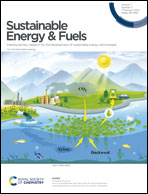Boosting photocatalytic H2 evolution through interfacial manipulation on a lotus seedpod shaped Cu2O/g-C3N4 p-n heterojunction
Abstract
Precisely modulating the interfacial contact of heterojunction photocatalysts and regulating the spatial transfer of photoexcited charge carriers play a significant role in promoting the photocatalytic efficiency. Herein, a novel lotus seedpod shaped Cu2O/g-C3N4 p-n heterojunction composite was fabricated by in situ filling the g-C3N4 framework with Cu2O hollow nanospheres. The obtained Cu2O/g-C3N4 p-n heterojunction presents superior photocatalytic H2 evolution activity with an optimal production rate of 637.5 μmol g−1 h−1, which is 40 times higher than that of pure g-C3N4. Through the combination of characterization and density functional theory (DFT) calculations, the boosted photocatalytic activity of Cu2O/g-C3N4 is attributed to the optimized p-n heterojunction structure with a proper band configuration and suitable heterojunction interface, which can improve the spatial separation of the photoexcited charge carriers and promote the charge transfer efficiency. This investigation is expected to highlight the promising scope of rationally constructing a p-n heterojunction with ideal interfacial contact, and intelligent regulation of the spatial separation of photoexcited charge carriers for photocatalytic water splitting.



 Please wait while we load your content...
Please wait while we load your content...